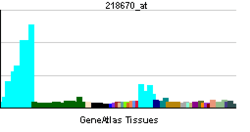PUS1
tRNA pseudouridine synthase A is an enzyme that in humans is encoded by the PUS1 gene.[3][4]
PUS1 converts uridine into pseudouridine after the nucleotide has been incorporated into RNA. Pseudouridine may have a functional role in tRNAs and may assist in the peptidyl transfer reaction of rRNAs (Chen and Patton, 1999).[supplied by OMIM][4]
References
Further reading
- Strausberg RL, Feingold EA, Grouse LH, et al. (2003). "Generation and initial analysis of more than 15,000 full-length human and mouse cDNA sequences". Proc. Natl. Acad. Sci. U.S.A. 99 (26): 16899–903. doi:10.1073/pnas.242603899. PMC 139241
 . PMID 12477932.
. PMID 12477932.
- Bykhovskaya Y, Casas K, Mengesha E, et al. (2004). "Missense mutation in pseudouridine synthase 1 (PUS1) causes mitochondrial myopathy and sideroblastic anemia (MLASA)". Am. J. Hum. Genet. 74 (6): 1303–8. doi:10.1086/421530. PMC 1182096
 . PMID 15108122.
. PMID 15108122.
- Gerhard DS, Wagner L, Feingold EA, et al. (2004). "The status, quality, and expansion of the NIH full-length cDNA project: the Mammalian Gene Collection (MGC)". Genome Res. 14 (10B): 2121–7. doi:10.1101/gr.2596504. PMC 528928
 . PMID 15489334.
. PMID 15489334.
- Wan D, Gong Y, Qin W, et al. (2004). "Large-scale cDNA transfection screening for genes related to cancer development and progression". Proc. Natl. Acad. Sci. U.S.A. 101 (44): 15724–9. doi:10.1073/pnas.0404089101. PMC 524842
 . PMID 15498874.
. PMID 15498874.
- Patton JR, Bykhovskaya Y, Mengesha E, et al. (2005). "Mitochondrial myopathy and sideroblastic anemia (MLASA): missense mutation in the pseudouridine synthase 1 (PUS1) gene is associated with the loss of tRNA pseudouridylation". J. Biol. Chem. 280 (20): 19823–8. doi:10.1074/jbc.M500216200. PMID 15772074.
- Beausoleil SA, Villén J, Gerber SA, et al. (2006). "A probability-based approach for high-throughput protein phosphorylation analysis and site localization". Nat. Biotechnol. 24 (10): 1285–92. doi:10.1038/nbt1240. PMID 16964243.
- Fernandez-Vizarra E, Berardinelli A, Valente L, et al. (2007). "Nonsense mutation in pseudouridylate synthase 1 (PUS1) in two brothers affected by myopathy, lactic acidosis and sideroblastic anaemia (MLASA)". J. Med. Genet. 44 (3): 173–80. doi:10.1136/jmg.2006.045252. PMC 2598032
 . PMID 17056637.
. PMID 17056637.
- Olsen JV, Blagoev B, Gnad F, et al. (2006). "Global, in vivo, and site-specific phosphorylation dynamics in signaling networks". Cell. 127 (3): 635–48. doi:10.1016/j.cell.2006.09.026. PMID 17081983.

 . PMID 10094309.
. PMID 10094309. . PMID 12477932.
. PMID 12477932. . PMID 15108122.
. PMID 15108122. . PMID 15489334.
. PMID 15489334. . PMID 15498874.
. PMID 15498874. . PMID 17056637.
. PMID 17056637.